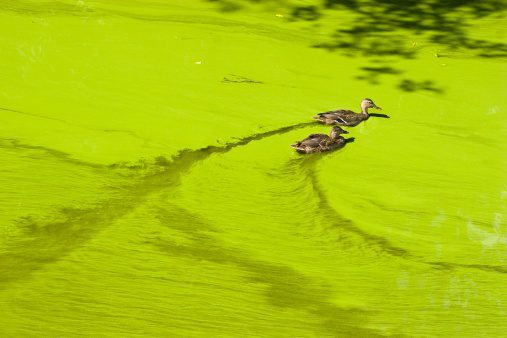
by Kerry McKinney, DVM
Michigan summers are a special treat for those who love outdoor water activities. With over 2200 miles of freshwater coast—and over 3200 miles if you count our islands!—we beat every state in the country. And almost everyone has a memory of a day at the lake, a trip down a river, or a picnic by the pond.
We’re also a big agricultural state, and the addition of phosphorous-containing fertilizers and livestock run-off to our waterways in combination with warm temperatures and slow-moving or stagnant water can lead to increased growth of algae and cyanobacteria (aka blue-green algae). These microorganisms produce “blooms” of bright green, blue-green, or purple-brown mats on the water surface and produce multiple toxins which are deadly to fish, livestock and pets.
If your pup is a water-loving, dock-jumping, kayak-circling, dog-paddling, shore-slurping fan of all things wet, keep him safe this summer by avoiding any algae-containing water.
Cyanotoxin poisoning can cause death via liver failure or respiratory paralysis. Signs of intoxication can include vomiting, diarrhea, drooling, weakness, muscle tremors and seizures; onset is often within 30 minutes of ingestion. If your pet has had access to algae-containing open water, and especially if you notice green slime on the fur of his feet or around his mouth, bathe him immediately. If he appears ill, seek emergency veterinary care.
Thus far in 2018, one case of algal toxicity in a dog has been reported following ingestion of water from a lake in Genesee County. To report suspected bodies of water and for help identifying toxic algae, please contact the Michigan Department of Environmental Quality: 800-662-9278 or algaebloom@michigan.gov.
More information on HABs and lake monitoring tools can be found on the DEQ website.
Recent Posts
About Us
Ann Arbor Animal Hospital is a locally-owned animal hospital operating for over 90 years in Ann Arbor, MI.
